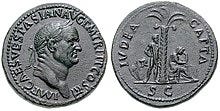Destroying the Jerusalem Temple
Part Two: Jesus and Vespasian
In the first of this four-parter, we looked at five similarities between the public ministry of Mark’s Jesus and the Emperor Vespasian. Now we turn to a sixth theme which is shared by both of their careers: the destruction of the Temple in Jerusalem.
6. The Temple
Perhaps the most striking similarity between Vespasian and Mark’s Jesus is that both were believed to stand behind the destruction of the Jerusalem Temple in 70 CE.
Historically speaking, Vespasian was instrumental in Jerusalem’s downfall. He had been personally entrusted with quelling rebellion in Judea by Nero in 68 CE. And just two years later, the city and Temple were ravished by his son, Titus, who had been placed in charge of a Roman legion by his now-Emperor father.
The ruin of Jerusalem was not an incidental moment in Vespasian’s career. It was the emblem of his propagandistic machine, blazoned across the Empire to legitimate his reign.1 To commemorate his victory, Vespasian threw a huge military triumph, erected monuments, and minted a set of coins showing the submission of the Jews.

Vespasian’s triumph over Jerusalem would arguably have caused a theological crisis for some early Jesus followers. Particularly for Gentile converts to the fledgling movement, it would have raised the question: Was YHWH – the God of the Jews – really in control of world history, or was it Vespasian and Rome?
Writing under the shadow of this propaganda, it makes good sense that Mark devotes so much of his text to the Temple and its demise. It was imperative that he counter the notion that Vespasian and the Roman gods were stronger than YHWH.
How then does Mark rebut the notion that Rome had defeated YHWH? In a stroke of genius, he claims that Jesus got there first. A generation before Vespasian, God’s appointed Messiah had recognised the Temple was corrupt and had prophesied its total destruction. This is the concern which dominates Mark 11-13.
Mark 11-13: The Temple’s Destruction
Throughout this unit, a number of scenes foreshadow the Temple’s demise.2 When Jesus first arrives at the Temple, he observes its corruption. Famously, his response is ‘to drive out those who sold and those who bought in the temple, and he overturned the tables of the money-changers and the seats of those who sold pigeons.’
This scene is often dubbed the 'cleansing of the Temple’ – the idea being that Jesus wanted to restore the Temple to its proper use. But if that is the case, it is unclear why Jesus removed not only the sellers but the buyers. It seems like this is a prophetic action to stop the machinations of the Temple entirely – an omen of its destruction.
Even more ominously, this scene is surrounding by two episodes about a fig tree – a common image of Israel. When Jesus first sees the tree, he curses it so that it no longer bears fruit. And when he steps out of the Temple, it has withered altogether. With Mark’s favourite method of ‘sandwiching’, the withering of the fig tree gives meaning to Jesus’ symbolic action within the Temple: it will come to sudden ruin.
Following this scene, Mark builds on this motif with Jesus’ parable of the wicked tenants, who fail to offer fruit for their landlord. The landlord (God) even sends his own son (Jesus) to collect the fruit, but they kill him. As a result, the landlord takes the tenants (the Jerusalem authorities) and gives their land to others (the Romans).

Finally, Jesus is clear about the Temple’s destruction. When his disciples marvel at its construction, Jesus replies, ‘Not one stone here will be left on another; every one will be thrown down…’ For Mark, it is clear that God’s appointed messiah, Jesus – not Vespasian – was ultimately in control of the Temple’s destruction.
In support of this rhetorical strategy – that it was God, not a foreign power, who was responsible for the Temple’s destruction – we might note that Mark was not the first biblical author to ‘defend’ YHWH in this way. Isaiah makes the same move, claiming that it was not the Babylonians who were responsible for the first Temple’s destruction, but God:
“Who gave up Jacob to the spoiler, and Israel to the robbers? Was it not the LORD, against whom we have sinned, in whose ways they would not walk, and whose law they would not obey? So he poured upon him the heat of his anger and the fury of war; it set him on fire all around, but he did not understand…’ (42:24-25)
Keep reading with a 7-day free trial
Subscribe to Behind the Gospels to keep reading this post and get 7 days of free access to the full post archives.

